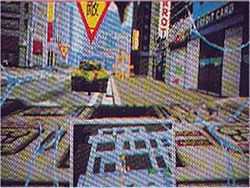Tokyo Wars
| Tokyo Wars | |
|---|---|
 European arcade flyer | |
| Developer(s) | Namco[1] |
| Publisher(s) | Namco[2] |
| Platform(s) | Arcade[2] |
| Release date(s) | |
| Genre(s) | Action[2] Simulator[1] |
| Mode(s) | Single-player[1] Multiplayer (from 2 to 8 players in multiplayer mode[1]) |
| Cabinet | Sit-down[3] |
| Display | Raster[4] |
Tokyo Wars (トーキョーワォーズ Tokyo Wozu, "Tokyo Wars")[4] is a 1996 first-person action video game developed and published by Namco for the arcade. The storyline provided by the game's promotional poster states that the game takes place in the 1990s.
This video game is the spiritual successor of Atari (Kee Games) 1974 arcade classic Tank and had its own spiritual successor with the 2009 Namco arcade game Tank! Tank! Tank!.
Gameplay

This game allows one to eight players to control separate tanks (either as teammates or as opponents).[5] The player(s) can play either in the heart of downtown Tokyo or at the city's bayside dock.[5] However, the players have twenty seconds to make all the decisions before the game automatically locks them in.
The deluxe cabinets features a pneumatic haptic control that simulates the recoil effect from the tank's main gun.[4][5] Since the regular cabinets do not offer an air-powered recoil, the deluxe edition delivers slightly more realism than the normal cabinet.[5] Arrows on top the screen help determine teammate from opponent because twenty tanks are rushing down the battlefield looking for an easy kill. While cars can always be demolished by crushing them over, some of the passageways in the game would crumble under the weight of the massive tanks.[6]
A game only lasts for fifteen minutes or until all opposing tanks are shot down. The game uses Namco's Super System 22 board,[4] with a custom cabinet. Players must sit down in order to play the game. Games can be played either as a competition with human players on both sides or cooperatively on the same team against AI-controlled opponents. Unlike most arcade games, high scores are not recorded and initials are not used to discriminate between the first player and the second player. The player has to look in his or her monitor to find out whether he or she has vanquished the opposition (which consists of twenty tanks[5]). Although only two players can play at a time, up to four machines can be interconnected to provide up to eight players a chance to compete in tournament-style matches.[5]
The official arcade soundtrack was released exclusively in Japan on November 19, 1997 as a music CD. While most of the songs were originally in the game, some of them have been arranged by Mr. Akihiko Ishikawa; who was the composer for the soundtrack.[7]
Types of tanks
The tanks have different colors; the Green Godzillas use the green for their battle vehicles and drive Mitsubishi Type 90 tanks while the White Mammoths drive white Uralvagonzavod T-72 main battle tanks.[8][9]
| Reception | ||||||||||||||||||||||||||||||||||||||||||||||||||||||||||||
|---|---|---|---|---|---|---|---|---|---|---|---|---|---|---|---|---|---|---|---|---|---|---|---|---|---|---|---|---|---|---|---|---|---|---|---|---|---|---|---|---|---|---|---|---|---|---|---|---|---|---|---|---|---|---|---|---|---|---|---|---|
| ||||||||||||||||||||||||||||||||||||||||||||||||||||||||||||
References
- ↑ 1.0 1.1 1.2 1.3 "Developer information". Killer List of Videogames. Retrieved 2008-10-18.
- ↑ 2.0 2.1 2.2 2.3 "Release information". GameFAQs. Retrieved 2013-07-23.
- ↑ "Type of cabinet". allgame. Retrieved 2011-12-15.
- ↑ 4.0 4.1 4.2 4.3 "Advanced information". Coinop.org. Retrieved 2008-10-18.
- ↑ 5.0 5.1 5.2 5.3 5.4 5.5 "Misc. information". Everything2. Retrieved 2010-09-27.
- ↑ "Best Arcade Game You Can't Play at Home - Tokyo Wars". Giant Bomb. Retrieved 2012-12-30.
- ↑ "Soundtrack information". Video Game Music Database. Retrieved 2012-12-16.
- ↑ "Green Team information". Internet Game Cars Database. Retrieved 2012-11-13.
- ↑ "White Team information". Internet Game Cars Database. Retrieved 2012-11-13.